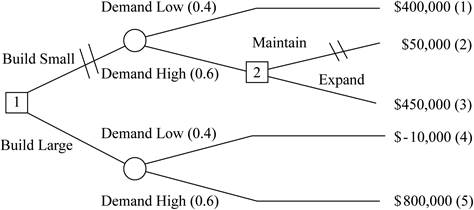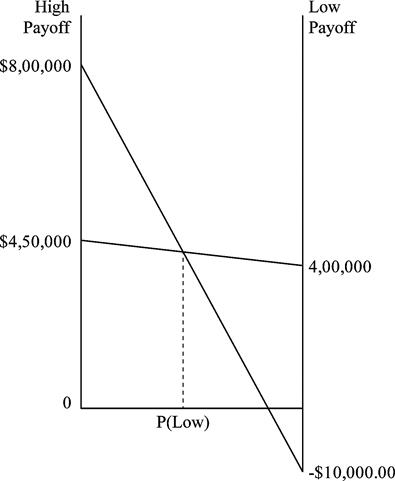
a)
To draw: A decision tree diagram.
Introduction:
Decision tree is one of the methods used in decision-making process. It would graphically represent the available alternatives and states of nature. It would also mention the payoffs and probabilities of the alternatives. It helps to choose the best alternative that would give the best result among the alternatives.
a)
Answer to Problem 4P
Explanation of Solution
Given information:
If small facility is build:
When demand is lower, then
When demand is higher, then two alternatives are as follows:
First alternative: To maintain and NPV is $50,000
Second alternative: To expand and NPV is $450,000
If large facility is build:
Demand is high: NPV is $800,000
Demand is low: NPV is -$10,000
Decision tree diagram:

Explanation:
Here we see that there are (1) two alternative decision small facility to build or to large facility to build. First alternative is to build small facility and there is also two sub parts, first is low demand and second is high demand. In high demand there are (2) two alternative decisions which has also two parts; first has to be maintained and other is expand.
Decision is based on right to left in decisions. We can see that expand have higher NPV that other alternatives.
Calculate the decision alternative payoffs:
It is given that probability of low demand is 40%, and high demand is 60%.
Small facility to build:
If low demand:
Therefore, the payoff of low demand is $160,000.
If high demand:
Therefore, the payoff of high demand is $270,000.
Large facility to build:
If low demand:
If high demand:
Calculate the expected value of each alternative:
Small facility to build:
Large facility to build
Here, we see that highest expected value is for larger facility to build so this alternative need to select and small facility alternative have double slash.
b)
To determine: To calculate expected value of perfect information.
Expected value of perfect information: It is the rate that a person is willing to pay to gain access to get perfect information. A common area which uses expected value of perfect information is the healthcare economy. This value tries to evaluate the expected cost of the uncertainty, which can be interpreted as the expected value of perfect information.
b)
Answer to Problem 4P
Explanation of Solution
Explanation
Calculation of expected value of perfect information:
Step 1: Calculate the expected value with perfection information or Expected payoff under certainty:
Therefore, expected value with perfection information is $640,000.
Step 2: Calculation of the expected value of perfect information:
Hence, the expected value of perfect information is $164,000.
c)
To determine: The range over each alternative that are best in term of the value of P.
Introduction: Decision table to evaluate the range over each alternative. Decision table is formats or visual representations were data is expressed arranged, determined and calculated to make an effective decision making. A decision table is a tabular representation that is used to analyze decision alternatives and states of nature.
c)
Explanation of Solution
Decision table is based on each alternative which are relative to P (low) and graph of low demand and high demand:
| Alternative | High Demand | Low Demand |
| Build Small | $450,000 | 400,000 |
| Build Large | $800,000 | -$10,000.00 |

From the above graph we can obtain that optimal value of P (low) over each alternative are, for low value of P (low) here we decide to build large facilities because we are getting higher expected value. For high value of P (low) we decided to build small facility because we are getting higher expected value.
Calculate the exact value of range:
Equations:
Build Small: 450,000 – 50,000P (slope = 400,000 – 450,000)
Build Large:800,000 – 810,000P (slope = -10,000 – 800,000)
Find the intersection between the two lines:
Optimal ranges:
Build Large: P (Low) = 0 to < .4605
Build Small: P (Low) > .4605 to 1.00
Want to see more full solutions like this?
Chapter 5 Solutions
Operations Management (Comp. Instructor's Edition)
- The City Commission of Nashville has decided to build a botanical garden and picnic area in the heart of the city for the recreation of its citizens. The precedence table for all the activities required to construct this area successfully is as follows: A Time B- Code Description (hrs) Immediate Predecessor(s) A Find location; determine resource requirements 20 None B Requisition of lumber and sand 65 A C Dig and grade 100 A D Saw lumber into appropriate sizes 30 B E Position lumber in correct locations 25 D, C F Nail lumber together E G Put sand in and under the equipment 25 F H H Put dirt around the equipment 10 F Put grass all over the garden, landscape, paint 35 G, H Refer to the legend for the activity that corresponds to each code. Using the line drawing tool, draw a Gantt chart for activities E through I of the project. 0 20 40 60 80 100 120 140 160 180 200 220 Clear allarrow_forwardList three forms of pay you receive (not dollar amounts). Compare your list to two of your peers. Discuss any differences or similarities that you noticed. NO AIarrow_forwardPlease and thank youarrow_forward
- A local fast-food restaurant processes several customer orders at once. Service clerks’ cross paths, sometimes nearly colliding, while they trace different paths to fill customer orders. If customers order a special combination of toppings on their burgers, they must wait quite some time while the special order is cooked. How would you modify the restaurant’s operations to achieve competitive advantage? Because demand surges at lunchtime, volume flexibility is a competitive priority in the fast-food business. How would you achieve volume flexibility? What are the potential downsides of relying too heavily on automation and standardization in this industry? What data would you want to gather, if any, before making recommendations?arrow_forwardWhat are 4 key points that are interesting about this video https://youtu.be/LAoMuvYZ_QM?si=Mognj_KBU9EIOLSParrow_forwarda) Select all of the correct impacts the maturing of a product might have on OM strategy below. (Check all that apply.) A. Cost cutting is instituted. B. Inventory needs to be revised. C. Labor skills decrease. D. Product design needs to be revised. E. Design compromises are instituted. F. New human resources skills.arrow_forward
- Please help! Multifactor!arrow_forwardKlassen Toy Company, Inc., assembles two parts (parts 1 and 2): Part 1 is first processed at workstation A for 10 minutes per unit and then processed at workstation B for 20 minutes per unit. Part 2 is simultaneously processed at workstation C for 12 minutes per unit. Work stations B and C feed the parts to an assembler at workstation D, where the two parts are assembled. The time at workstation D is 15 minutes. a) The bottleneck of this process is at minutes per unit (enter your response as a whole number).arrow_forwardJust HELParrow_forward
- I need help with C. I'm strugglingarrow_forwardBy signaling their willingness to share information about their interests, but not their BATNA, a negotiator can capitalize on the powerful principle of reciprocity. Which of the following situations best illustrates the reciprocity principle? Group of answer choices A. A car salesman shares information about the town where he grew up, and his custo.mer shares that he also grew up near that town B. A cab driver takes a customer to her hotel and picks up a new customer at the hotel. C. A woman compliments a friend about her purse and the friend says thank you. D. An employee shares information about a project's progress with a coworker who is uncertain.arrow_forwardWhat benefits can negotiators get from using the strategy of multiple equivalent simultaneous offers (MESOs)? Give a real life example.arrow_forward
 Practical Management ScienceOperations ManagementISBN:9781337406659Author:WINSTON, Wayne L.Publisher:Cengage,
Practical Management ScienceOperations ManagementISBN:9781337406659Author:WINSTON, Wayne L.Publisher:Cengage, Purchasing and Supply Chain ManagementOperations ManagementISBN:9781285869681Author:Robert M. Monczka, Robert B. Handfield, Larry C. Giunipero, James L. PattersonPublisher:Cengage LearningMarketingMarketingISBN:9780357033791Author:Pride, William MPublisher:South Western Educational Publishing
Purchasing and Supply Chain ManagementOperations ManagementISBN:9781285869681Author:Robert M. Monczka, Robert B. Handfield, Larry C. Giunipero, James L. PattersonPublisher:Cengage LearningMarketingMarketingISBN:9780357033791Author:Pride, William MPublisher:South Western Educational Publishing



